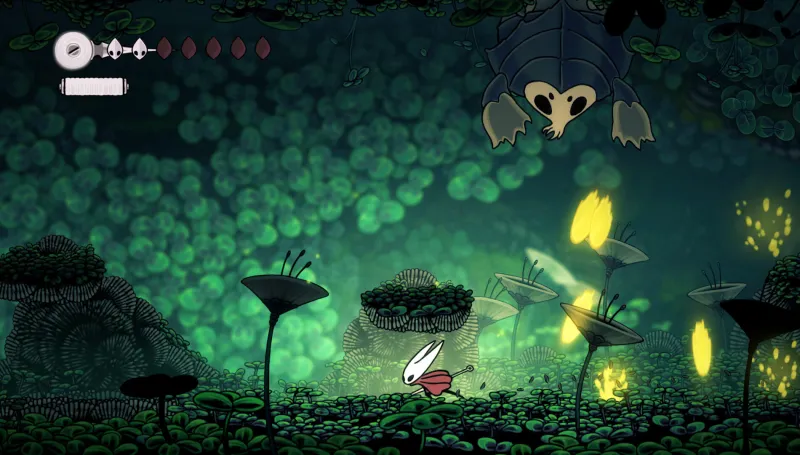

Our extra-large special edition is here. Subscribe today and receive the 25% longer issue at no extra cost!

Gamescom 2025 has begun, and I'm on site in Cologne, Germany, checking out more than two dozen new and upcoming games, ranging from Hollow Knight: Silksong to The Outer Worlds 2 to 007 First Light and beyond! I'll be doing individual write-ups for many of these games, but I'll also be writing condensed quick-hit thoughts on the coolest games I've played so far, and you can read them right here (so bookmark this page, folks!).
Below, you'll find a running list of the games I've played during Gamescom 2025.
Hollow Knight: Silksong

It's real, y'all. Hollow Knight: Silksong exists and is playable, and I checked out the game's very first level, Moss Grotto. After a brief cutscene that shows Hornet trapped in a Cinderella-like carriage (that she then breaks out of), I take control. Immediately, Hornet is much faster than the first game's protagonist, both as she platforms around and with her attacks. She has a new ability called Bind (used by pressing B on an Xbox controller) that heals her. However, you can't spam this ability as it requires using a bar on screen that must be full.
It recharges over time and by defeating enemies, and I found it pretty easy to get it full for another Bind. Platforming around Moss Grotto feels a lot like 2017's Hollow Knight, though Hornet is more nimble and can mantle up cliffs and platforms. The enemies here are easy to defeat, and it's not until I fight the demo's boss, Moss Mother, that I'm challenged. It's a fun fight, but still mostly easy.
With the demo and my hands-on time with Silksong behind me, I'm excited to see what else awaits me in the full game. If this first level is any indication, it's going to be a great Metroidvania, much like the first game. That said, I'm not convinced it's going to break through the hype and make a mark on the genre like the first game did. I'm also not convinced it needs to, though.
For more, read my full Hollow Knight: Silksong hands-on thoughts here.
Pokémon Legends: Z-A
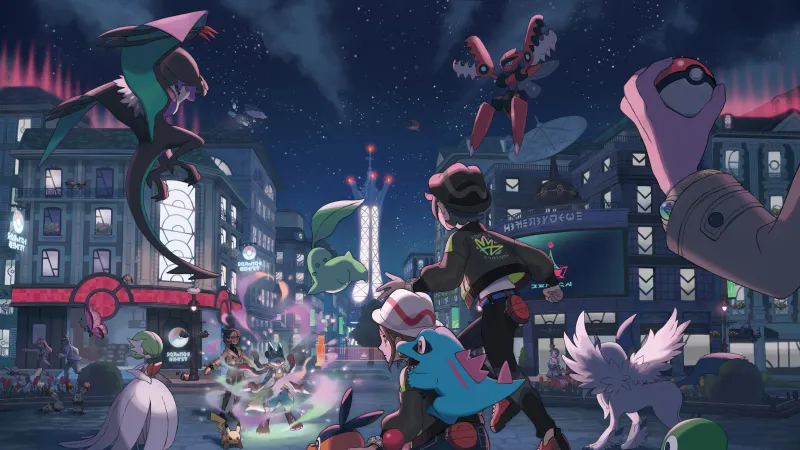
Pokémon Legends: Z-A is not just a sequel to The Pokémon Company's latest spin-off/experiment to its traditional Pokémon series, but also the first Pokémon game launching on Nintendo Switch 2. Though I'm not convinced the experience will be great on Switch, after 30 minutes of hands-on time with it on Switch 2, I'm starting to believe this will be the best Pokémon games in years.
My demo consisted of two parts: three trainer battles within a nighttime-exclusive battle zone, and a fight against a Mega-Evolved Absol. Stay with me here: Pokémon Legends: Z-A's combat reminds me most of Final Fantasy XII, something I suspected more and more as I heard more and more about its combat. It's real-time, but rather than mashing buttons to attack, you select moves in real-time that your Pokémon performs, then, while waiting for that move's cooldown to complete, use other moves. All the while, I'm dodging and running to get my Pokémon out of harm's way and utilizing stat-affecting moves to prime the opponent's Pokémon for my next move.
It's an exhilarating change to the Pokémon formula, and its MMO-like cooldown-focused combat reminds me of Final Fantasy XII's hybrid combat that fell somewhere between real-time and the timed combat of its MMO predecessor, Final Fantasy XI. I like switching Pokémon on the fly, using my knowledge of effectiveness to bring the right one out from my party, and I especially like sneaking up on unaware trainers to start the fight with a big advantage. These battles were simple, but I can already see how the challenge could ramp up in the full game.
In fact, I got a taste of that challenge in a 1v1 fight between my Lucario (capable of mega-evolution) and a Mega-evolved Absol. Not only did I have to balance my attack moves with my defensive ones like Protect to avoid fainting, but as the trainer, I had to dodge out of harm's way to prevent Absol from hurting me. This battle against Absol felt like an MMO boss fight where I had to pay attention to its moves and react and counter appropriately. Absol even had an AOE attack that blanketed the arena in damage after a brief charging period I could interrupt with a super-effective attack. This fight wasn't easy – I actually lost my first go – but it's a level of challenge I'm happy to see in a Pokémon game. I can't wait to see what else awaits in the final game this October.
Read my full hands-on preview thoughts here.
Keeper
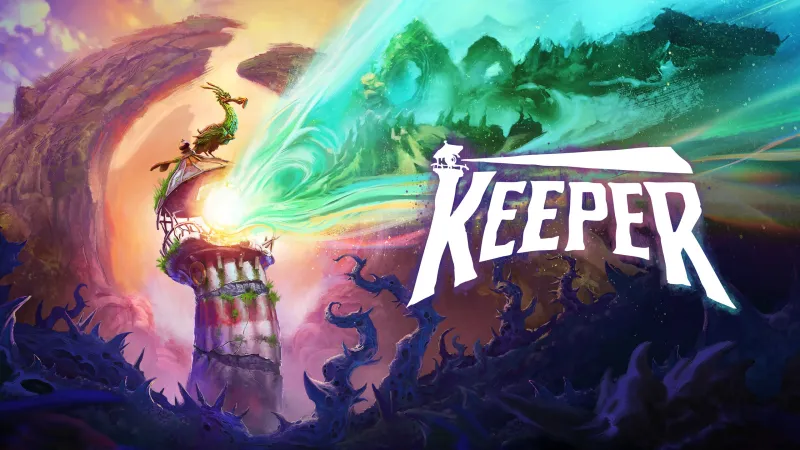
I didn't get to go hands-on with Keeper, but after a 30-minute hands-off preview of it, with developer Double Fine Productions' Tim Schafer no less, I wish I did. Set in a fantastical Salvador Dali surrealist world where humanity is no more and nature has taken over, Keeper is about a lighthouse with legs. And a sea bird named Twig. There's also a village of tiny lil guys that are actually clocks, a mystical area where pink pollen lowers your gravity, and so much more.
But I only saw snippets of this across three gameplay segments. At the heart of each is vibes and atmosphere, and according to Schafer, that's the heart of the game. There's no combat. There are some puzzles, but they short and sweet. There's no dialogue. Instead, Schafer and Co. want you bask in the ambiance of Keeper. I'll gladly do it, because that ambiance is great so far.
I'm excited to see how the core gameplay – walking around this island to reach its mountainous peak while using the lighthouse's light to illuminate objects – transforms across the game's runtime. Fortunately, I don't have to wait too long, because Keeper is out on October 17.
For more, read my full Keeper preview thoughts here.
The Blood of Dawnwalker
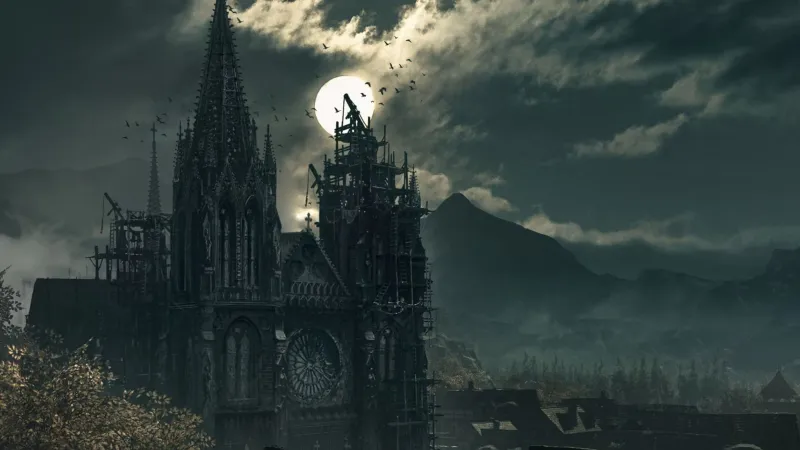
Rebel Wolves is a studio made up of former CD Projekt Red devs who worked on Cyberpunk 2077 and critically (for The Blood of Dawnwalker), The Witcher 3: Wild Hunt. I mention this because The Blood of Dawnwalker feels like another timeline's Witcher, except instead of fantastical monsters to hunt and execute, it's vampires.
Protagonist Coen is a Dawnwalker, which means he can tap into vampiric abilities at night and magic during the day. The day/night cycle is core to Dawnwalker, as Coen only has so many days to save his family. Every quest he completes has a time notch associated with it, and upon completing quests, Coen's timeline gains a few notches, slowly decreasing the amount of time he has left to save his family. I'm not quite sure how this works in full, but it's an interesting gameplay addition I'm excited to see more of.
The combat itself is... very Witcher, except it's not just swords; Coen can utilize his vampiric claws and other vampire abilites (like sucking the blood of enemies to regain health). During the day, when he's not tapped into his vampiric abilities, Coen can use magic, like speaking with the dead to learn critical information about quests and more.
If you watched gameplay of Dawnwalker, didn't know what it was, and called it Witcher, I wouldn't blame you. A lot of what it's doing is clearly a result of former Witcher devs creating a new IP. But with its vampiric twist, day/night cycle, and time restraint, it's clealry charting its own course through medieval times. It still has a ways to go – it's not set to launch until next year – but it's one I'll absolutely be keeping an eye on.
Knights of the Fall
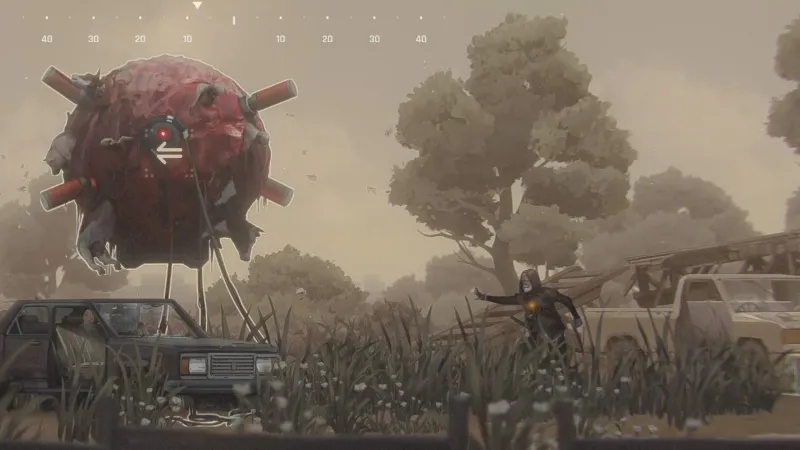
Knights of the Fall comes from Airo Games and is one of publisher Bohemia Interactive's five games in its Bohemia Incubator project. Though my hands-on time with Knights of the Fall was just an early look at what the team has planned for this game, its unique blend of 2D sidescrolling with tactical, combo-heavy combat has me intrigued.
There wasn't much story to my quick demo – I believe it's set in a post-apocalyptic Japan that's been decimated by a sci-fi phenomenon that has caused grotesque monsters to inhabit spaces once home to humanity. You play as a lone soldier of sorts, handy with a katana and a wrist-mounted gun. Using this gun, you can stun enemies, which opens them up to become victims of your gravity gadget. You can pull stunned enemies toward you and decapitate them, push them into other enemies (especially useful if they're an explosive enemy), or let them fly past you, opening you up for an easy escape.
That was my main method for taking down enemies, though utilizing the katana's three-hit combo and parries did well, too. In my short demo, the protagonist was after some long-forgotten logs, left somewhere in a house. I explored various houses in search of these logs, running into different enemies along the way. I enjoy the game's slower, more methodical pace in the 2D sidescroller space, and its unique art style makes it stand out even more.
Airo tells me there's still lots of work to be done – it hopes to release a demo or playtest of sorts for the public next year to try it out – but after my hands-on time with the game, Knights of the Fall is one I'm going to keep an eye on.
Borderlands 4
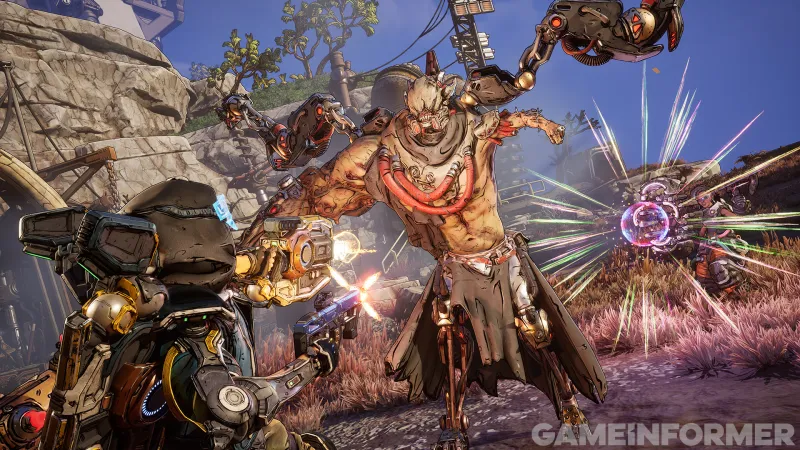
Game Informer has covered Borderlands 4 extensively – it was one of our recent cover stories after all. But that didn't stop me from giving it a go during Gamescom 2025. For this quick demo, I played through a vault mission where I had to defeat waves of enemies, including mini bosses and a final boss, to complete a journey to the end of a vault where tons of loot awaited me.
It was mostly a showcase of the game's combat, but I did notice how much more enjoyable (and less annoying) the writing was compared to Borderlands 3. It shows a lot more restraint than its predecessor. Sure, it's still the Borderlands humor you expect, but instead of 15 jokes a minute, it's a joke every couple of minutes. I really welcome this change of pace in its cadence of humor, and it allows me to focus better on the mission at hand. And that was crucial because reaching the end of this vault was tough work.
Enemies pursue you aggressively, forcing me to stay on the move throughout each wave. Bosses killed me more than once (and so did basic mob enemies), and I had to strategically think about when it was best to utilize my ultimate-like signature abilities. I felt challenged in a way that forced me to rethink my more casual approach to Borderlands 4 shootouts, and it was a feeling I really enjoyed. I look forward to seeing the other ways this game will keep me on my toes when it launches next month.
Black State
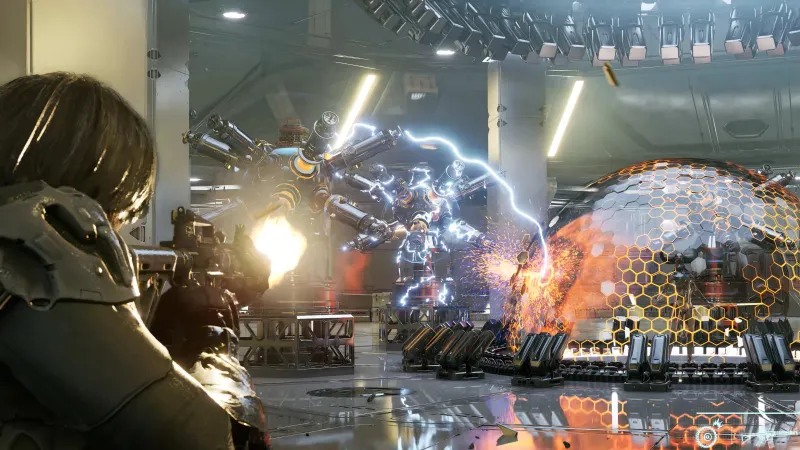
Developer Motion Blur's Black State is a game I knew very little about before encountering it here at Gamescom. It gives off big Unreal Engine 5 vibes (you know the vibes), and while I initially thought it could go the way of this year's MindsEye, I walked away from my half-hour of hands-on time with the game at least willing to give it a shot next time I can.
Set in a futuristic sci-fi world, it plays with time travel in a fun way. In my demo, the protagonist is warped to a military camp just moments after enemy forces there launches ballistic missiles into the sky. Because of the time travel shenanigans at play, our protagonist already knows these missiles will start the very war he's trying to prevent. It's a cool premise, but unfortunately, I don't learn too much more of the story at play here.
I do learn a lot about Black State's gunplay, which is serviceable. The machine guns and pistols feel fine, and the shotgun packs a nice punch, but I'm most intrigued by items like grenades. Instead of chucking them into the air, you roll them on the ground and they autonomously roll right to an enemy, sending their body parts flying in gory fashion. The same can be said for special electric stun grenades that are effective against robots. There's even a Cleaner grenade that lasers away bodies, removing those you've killed from the sightlines of other enemies in the area.
That Cleaner grenade is especially useful when utilizing stealth to dispose of enemies scattered about the military base I'm infiltrating. Motion Blur isn't reinventing the wheel with stealth in Black State and it's about what you expect – sneak up on enemies and then press a button to execute them.
The final aspect of Black State that intrigues me is its portal doors. Sometimes, when walking through a door, you can walk back through it and appear in a totally different place. I'm told this will be explained better in the final game when I understand the story more, but I'm hoping Motion Blur uses this tech and premise to take our protagonist to more unique places than military bases.
Pragmata
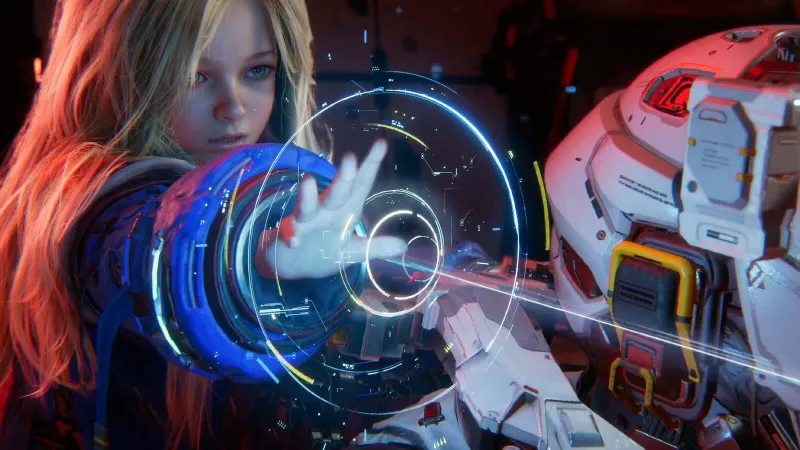
I played one of the first stages in Pragmata and I legitimately cannot wait to play more. It feels like a new type of game, something I haven't felt since 2019's Death Stranding. That's because it's one part a third-person shooter, another part a puzzle game. The unique twist of Pragmata, though, is that the third-person shooting and puzzle solving happen at the same time. That's because the little android girl that accompanies protagonist Hugh (I love that this dude, the protagonist of a wild sci-fi story, has such a normal name) has the ability to hack into enemies.
You do this by moving a cursor along a grid, ideally moving it through debuffs that affect the enemy upon completing the hack. This hack weakens the enemy (and can damage them, too), opening them up for some heavy damage via Hugh's pistol and other weapons he can use like a fusion rifle or trap gun. I really enjoy the added stress of solving these puzzles on the fly while engaging in third-person shooter combat, and even in the early stages of Pragmata, it's good fun. I imagine this fun and stress will ramp up later in the game.
The design of this world is great, too, with an excellent sci-fi soundscape to accompany your every action. Electricity sizzles, fire explodes across the screen, and every weapon sounds cool. It also looks great, ironically evoking a lot of Death Stranding's unique sci-fi vibe.
Capcom's more experimental games of late have impressed me greatly – looking at you, Kunitsu-Gami: Path of the Goddess – and Pragmata seems set on joining this string of releases. It's due out sometime next year, and I look forward to seeing what else is in store for Hugh and his hacker robot surrogate daughter.
Resident Evil Requiem
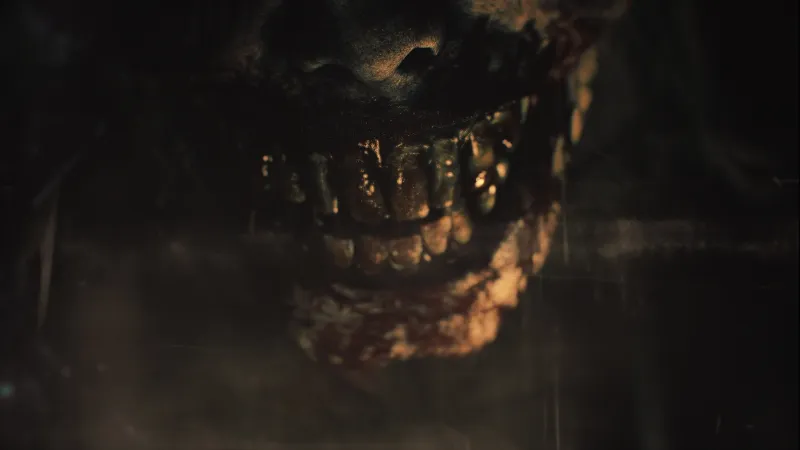
Y'all, we are so back; not that we ever left, because Capcom has been releasing banger after banger when it comes to its prolific survival horror series, but Resident Evil Requiem is already shaping up to be an excellent game. The demo I played wasn't anything new – it's what Capcom let Game Informer's very own Marcus Stewart played during Summer Games Fest this year – but it was my first time playing, okay!!
It begins with Grace Ashcroft upside down, strapped to a gurney, her blood being drained into blood bags... for some reason. If Ashcroft sounds familiar, you're probably recognizing it as the last name of Grace's mother, Alyssa, the playable Raccoon City field reporter from the Outbreak series of RE games.
My hands-on time with Requiem begins after a cutscene showing Grace strategically escaping from this gurney. My mission? Escape this decrepit care center. After stepping out of the room, I'm faced with a terrifying, dimly lit hallway, reminiscent of the hallway from P.T. Hands shaking, I head down it, attempting to find something to help me out of this hellhole.
I reach a storage room, but the light doesn't work and I can't see anything in the room. So I double back to where I started and go down the other side of the hallway. As I make my way to the end of the hallway, the walls and ceiling shake – I'm not alone.
I find a door adorned with Cherub imagery, but it's locked. I continue down the hallway, open a drawer, and find a Cherub key. I know what to do next. After opening the Cherub door, I frantically search for anything useful. I find a lighter! Aha! Light!
I dip back to the other side of the hallway and light up the storage room, but not before a dead body jump scare starts me and then something even more terrifying: a massive hulking monster that I can best describe as a woman with extremely large humanoid feet, draped in distressed cloth, with a face not even a mother could love. Something is very wrong with this creature, and she's hungry for me, it seems.
Grace is the more helpless, "god, how do I get out of here?" type of character. As such, I don't have a way to fight back against this creature, save for throwing bottles in the direction opposite of me as a distraction.
The next five minutes of my demo – also the last five minutes of my demo – can best be described as me poorly escaping the clutches of this creature while trying to find a way to access a battery stuck behind a screwed-in panel on a wall. I say poorly because I'm unsuccessful in time, dying at the hands of this monster. I'm not allowed to describe the game over death scenes of Grace, but they sure are something.
One last thing: I was able to switch back and forth between first-person and third-person perspectives. Both work extremely well in Requiem and I have no idea which one I'll choose for my full playthrough of the game.
Fortunately, you don't have to wait too long to see them for yourself because Resident Evil 9: Requiem launches February 27, 2026.
[Editor's Note: An earlier version of this Resident Evil Requiem write-up stated "Capcom has made clear that the dual protagonist approach of Requiem means Leon is the heroic action hero and Grace is the..." The article has been updated to remove this line, as Capcom has never stated anything about a dual protagonist system. Game Informer regrets the error.]
Warhammer 40,000: Dawn of War IV
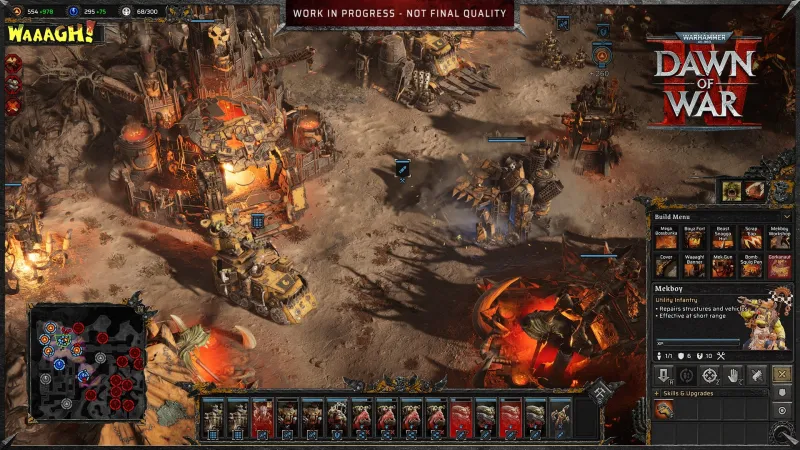
The single pre-alpha mission I played was simple: defeat the Ork base. I began at the bottom of the map and that base was at the top of the map. Dotted in between their base and mine were various neutral control points. Taking them over allows me to build various buildings where I can deploy more troops, elite soldiers, vehicles, and more. You absolutely cannot win without winning these control points, as they effectively allow you to move your base of operations and army manufacturing sites forward. Other than that, I needed to direct my soldiers and vehicles to hordes of enemies to defeat. It's all simple on paper, but much harder in execution.
I sucked at it. I don't want to suck at it. My desire to play more is rooted in beating this mission one day. And I will.
Reanimal
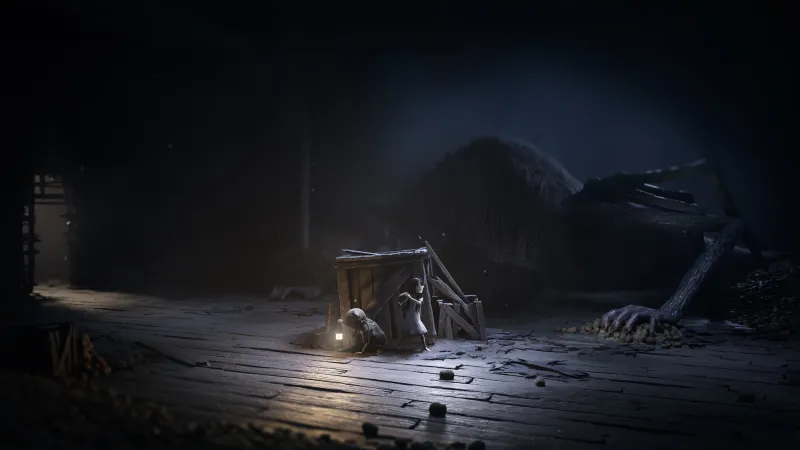
I love Little Nightmares I and II, both developed by Tarsier Studios, and though I'm excited for Supermassive Games' take on the series in Little Nightmares III, I'm more excited for Reanimal, the upcoming adventure game from Tarsier. It's set to launch sometime in early 2026, and after playing a quick 20-minute hands-on demo, I can't wait. It is a lot like Little Nightmares, but with a different coat of paint on it... on the surface. Small and smart tweaks to elements like its camera work, puzzles, and more show Tarsier still has more give to this genre.
During my demo, which I played in co-op alongside another member of the press, we needed to move a cart across some tracks over a massive gap. As you might expect, especially if you're familiar with Little Nightmares, puzzles required us to work together, sync button presses, and even work in tandem to properly work a see-saw lever up and down to move the aforementioned cart. During this section, we also encountered what I can best describe as meat sacks: the abandoned flesh of humanoid monsters without innards, and a large and terrifying farmer hat man. We hid under benches, snuck through grass, and sprinted for our dear lives to escape his clutches (but not before dying and being eaten by him first). It was a blast, and I enjoyed the extended control of the camera and use of an X-Y-Z plane, in terms of perspective, to make every action feel more cinematic.
We'll see how it pans out next year, but so far, Reanimal might turn out to be even scarier than Tarsier's Little Nightmare games, and it's undoubtedly going to be just as fun to play if this preview is any indication.
Ground Zero
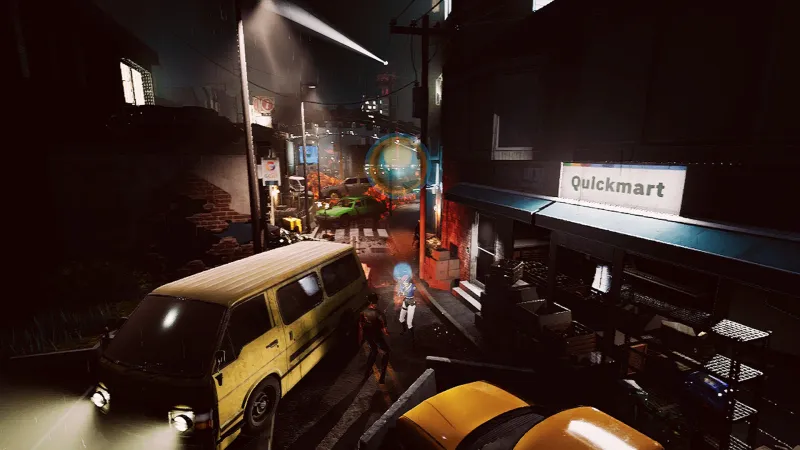
I cannot emphasize this enough: if you are not paying attention to Ground Zero, you should be. Coming from Sweden-based newcomer studio Malformation Games, Ground Zero is – wait for it – a survival horror game set in post-apocalyptic South Korea with visuals and gameplay inspired by PS1-era titles like Resident Evil. It has save rooms, inventory management, tank controls (as well as more modern controls), fixed camera angles, and 2D pre-rendered backgrounds.
Dropped into South Korea's Busan, special forces agent Seo-Yeon, with help from an agent companion named Evan, will travel more than 125 miles in her journey across a ruined South Korea to Daejeon as she tries to piece together what's become of the country after a meteor strike has morphed humans into monstrous creatures. It looks and plays like a PS1-era survival horror, but features unique touches that make it distinctly its own. I'll elaborate more in the separate preview I plan to write for Ground Zero, but just know: if you're a survival horror sicko, you should keep an eye out for Ground Zero.
Exoborne
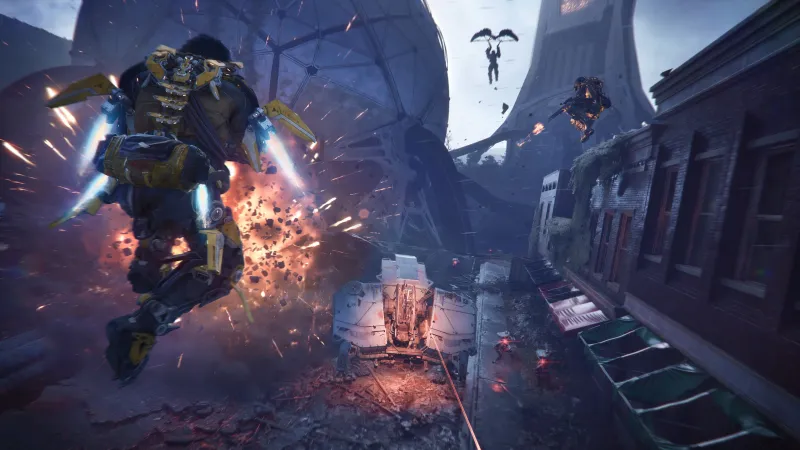
I enjoyed my Exoborne demo so much that it has me wondering if maybe I've been wrong – maybe I am an extraction shooter sicko. Perhaps "sicko" isn't the right word, considering I've barely dipped my toes into the genre, but it's a style of game I rarely pay attention to. After 30 minutes with Exoborne, I am, at the very least, going to start taking notice. In fact, it has a closed playtest coming up next month, and I'm hoping to get into it.
It follows the extraction shooter formula closely: drop onto a map, take out enemy AI and other actual players, loot as much as you can, and get out with all of it intact. Oh, and if you die, none of that loot comes with you. It has a lot of risk versus reward opportunities. But Exoborne's twist on the formula comes in the form of futuristic skeletal rigs that grant you special abilities, like being able to super-jump and hover via jetpack, and post-apocalyptic weather. There's fire, lightning, and, as I experienced in my demo today, tornadoes.
Of course, this weather poses a threat, but it can also be used to your advantage. I loved using tornadoes to launch into the air and glide to safety and looting what I wanted amidst a firefight. I look forward to seeing how other types of dangerous weather shift the tides of the various combative encounters Exoborne follows with each extraction run.
Rewilders: The Last Spring
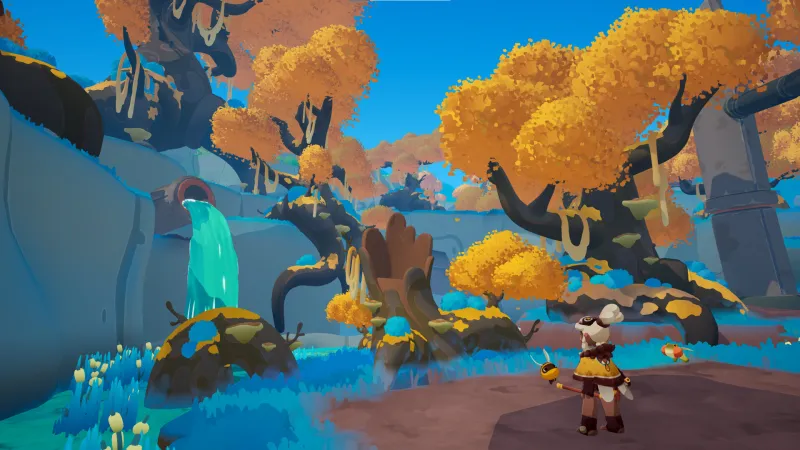
I really enjoyed Herobeat's Endling – Extinction Is Forever, an adventure game about foxes with something to say about the environment and humanity's impact on it. After watching some Herobeat devs play the team's next game, Rewilders: The Last Spring, I'm excited for more. Like Endling, it, too, has something to say about the environment, this time about humanity's destruction of nature and its effect on the natural world, but it's wrapped up in a mechanical package I prefer: roguelike.
After your four siblings are consumed by hatred, they become bosses scattered around a destroyed land. Your mission is to explore these lands, restore life to your siblings, and defeat them to save them. Rewilders is a run-based roguelike, so the world you explore and restore is different in each run, but the Hantus – fictional animals with abilities you use in combat that populate your airship home base – stay with you. You can upgrade their skills, teach them new ones, and mix and match your playstyle based on the ones in your four-Hantu party. Alongside Hantus, you'll fight off once-beautiful creatures poisoned by the environment's destruction in third-person Dark Souls-inspired combat.
The entire package is wrapped up in a cozy visual style, and I look forward to seeing if Rewilders can successfully marry two communities – Soulslike and cozy fans – to create something unique in the roguelike space.
Lego Batman: The Legacy of the Dark Knight
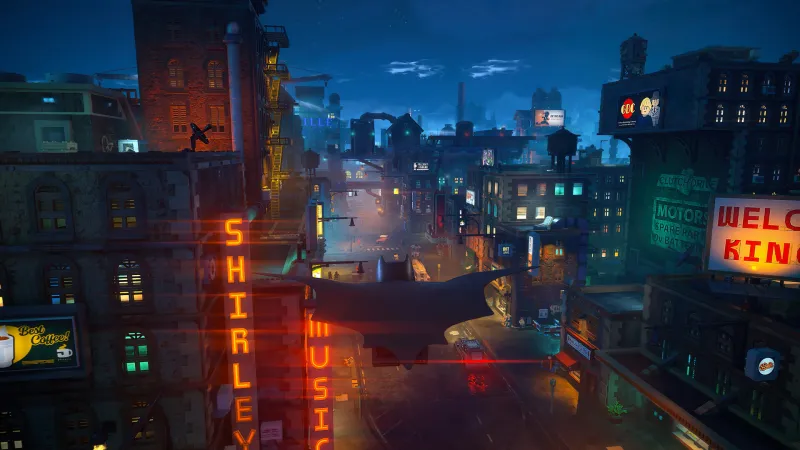
I will have a lot more to say about this game very soon after I write a separate preview for it, but Lego Batman: The Legacy of the Dark Knight is easily the most exciting release from developer TT Games' history, for me. It is a Lego Batman game based on the movies I love – pretty much all of the Batman movies in the character's lineage – while also pulling inspiration from other Batman media, such as TV shows and comics. And, perhaps most excitingly, it's heavily cribbing the combat from Rocksteady's Batman Arkham games to create easily TT Games' best combat.
After roughly 45 minutes with the game, exploring the open-world Gotham City and playing through a full mission set in ACE Chemicals, I'm comfortable betting that Legacy of the Dark Knight will join games like Arkham Asylum and City as some of the best superhero games ever made. The humor, charm, collectibles, and reverence TT Games has always excelled at are here, but now the studio is using a world-class combat system as the basis for its latest take on the Caped Crusader, and it feels incredible.
Stay tuned for more of my thoughts on Legacy of the Dark Knight, including some information I learned from an interview with one of its lead developers.
Crimson Desert
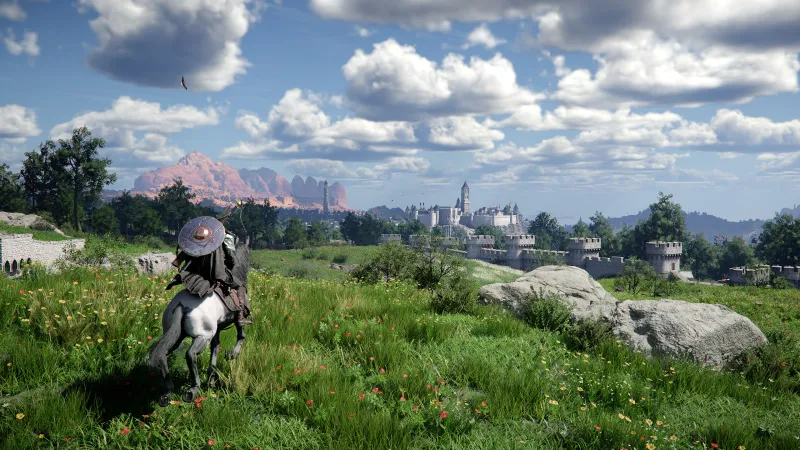
After a new 45-minute demo with Pearl Abyss' Crimson Desert, which starts with a brand-new tutorial tweaked heavily following fan feedback before placing me in the center of a chaotic battlefield, I continue to be heavily intrigued by this game. It is doing so. dang. much. Every time I learn more about the game, I believe a little more and more that this team might pull it off, but there is truly a staggering amount of systems and mechanics in this open-world single-player RPG.
The tutorial alone took me 15 minutes, and it features a staggeringly large number of moves and combos to complete actions. For example, to lift a banner flag and place it into a control point – a critical aspect of gaining ground on the battlefield – I had to press L3 + R3 to go into Focus mode, then press Triangle + Circle to pick up the banner, then press X rapidly to lift the banner, then press Triangle to hold the banner once it's been fully lifted off the ground, then walk it over to the control point, and press L1 + another button I can't remember to place the banner in the control point. Okay, it sounds ridiculous typing it out, and it somewhat felt the same in practice.
But I can't deny that I'm intrigued by the way these myriad systems interact with each other and work in practice in combat, exploration, and elsewhere in Crimson Desert. There's so much happening in the game that it almost feels fake, but it's not – I played it.
Project Spectrum
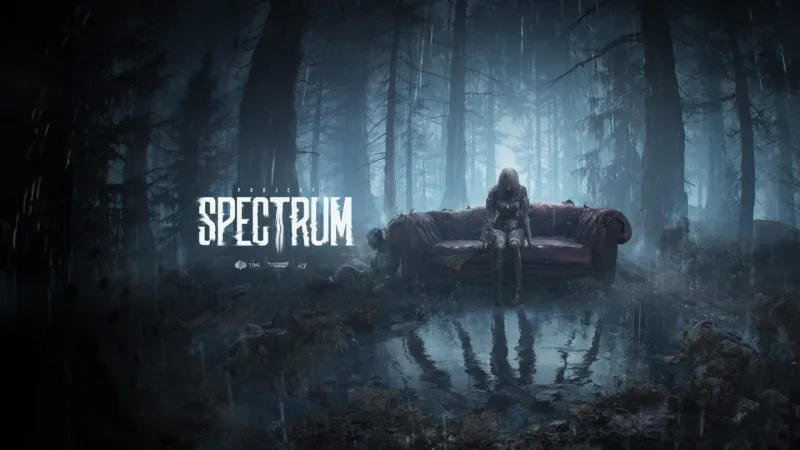
Project Spectrum comes from China-based studio, Team Jade, and one of its main leads is a former Call of Duty: Mobile designer. As is becoming increasingly frequent in China, a mobile developer/team is looking to break into the triple-A world , and Project Spectrum presents an interesting case for why horror fans should keep an eye on Team Jade's next title.
It's an asymmetrical first-person multiplayer shooter that features soldiers called agents, PvE elements, and a controllable Executioner, a Symbiote-like thing that stalks agents while they investigate anomalies and other supernatural elements. Before Team Jade told me, I could already tell Project Spectrum is inspired by Annihilation and Arrival, and I learn during a Q&A with the team that other inspirations include the S.T.A.L.K.E.R. books, too.
Project Spectrum is a tactical first-person shooter, the kind where every bullet counts, and it features a unique "Sanity" system that directly affects what you see. Bad weather, enemies, and more can bring your sanity down, causing you to hallucinate and see the world differently. That this happens while a player-controlled Executioner stalker is hunting you makes it all the more exciting. It's still somewhat early in development – production only began last year – but what I saw was unique enough to guarantee I'll keep an eye on this asymmetrical multiplayer game, a genre I typically don't care to monitor.
Recur
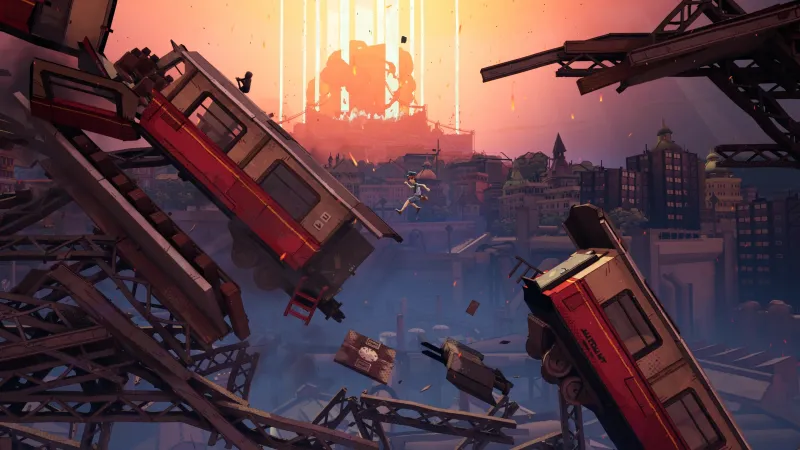
Braid fans, this one's for you. Recur comes from Germany-based studio kaleidoscube and uses time-advancement elements to create unique puzzles in a world with a visual style inspired by Spider-Man: Into the Spider-Verse. It helps that one of the developers actually worked on that film. The premise is this: your world is ending, you need to save it, and when you walk right, time advances, and when you walk left, time reverses.
I only got to play 15-ish minutes of Recur, but I really enjoyed solving the puzzles presented to me using this unique time mechanic. It took a second for my brain to understand how I could use this mechanic to solve puzzles, but once it clicked, I wanted more. Unfortunately, I only got a taste of Recur's puzzles, but I can't wait for more. However, if you think you're immediately turned off by how many times I used the word "puzzle" here, fret not – Recur's director tells me Recur isn't really a puzzle game, but rather, an adventure game with some puzzles. I look forward to learning what that means when Recur launches sometime in the future.
BPM Bitcrushed
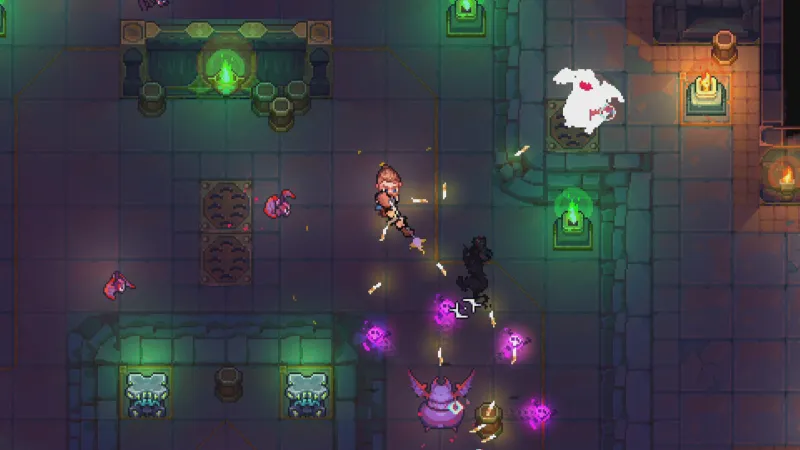
BPM Bitcrushed is a run-based roguelite with procedurally generated dungeons, enemies, and bosses, where every action you complete must be done to the rhythm of a song. And on PC, that song can be anything you want thanks to friendly custom music tools, so yes, I did watch developer Awe Interactive complete a stage to Britney Spears' "Hit Me Baby One More Time."
In BPM Bitcrushed, rock opera is the primary genre of music when you aren't using custom tracks on PC, and it fits in nicely with the Norse Mythology-inspired story where the game's cast of heroes is attempting to stop Ragnarok. At the bottom of the screen is a tempo/rhythm keeper, and every shot, jump, dodge, and any other action you perform must happen on beat using this tool. If you try to shoot off-beat, nothing will happen, and instead, the action will register on the next beat. It's a nice touch for those who aren't too great at keeping a tempo.
Traversing through the game's retro pixel stages is a treat for the eyes, and there's plenty of weaponry to use, passive abilities to find, treasure chests to loot, and enemies to defeat, so it doesn't look like there's much time to breathe in BPM Bitcrushed (in a good way). While Awe Interactive is aiming to release the game in Q2 of 2026 (though an exact release is still TBD) on PlayStation 5, Xbox Series X/S, Switch, and "maybe" Switch 2, BPM Bitcrushed is a game I will play on PC. Not only can you upload custom music into the game, which only requires you to plug in a BPM and the game handles the rest, you can create a whole playlist of songs to play during your runs; the game then automatically adjusts timing, enemies, and more on the fly to accommodate your different tracks. That's a really neat, player-forward feature I look forward to seeing in action next year.
Cinder City
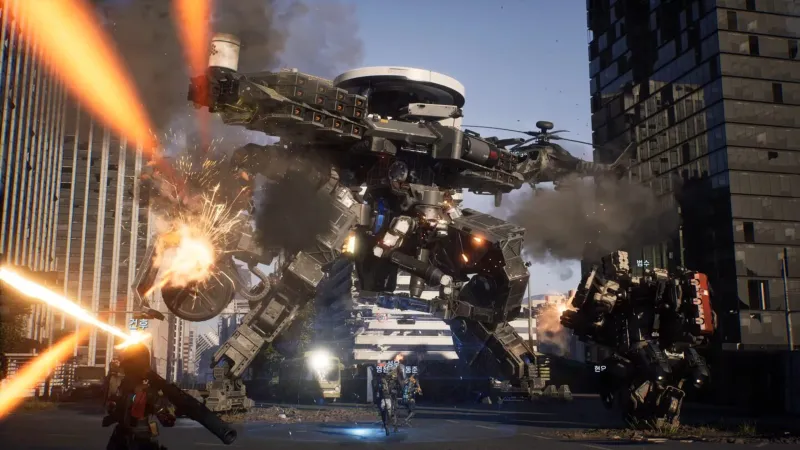
Cinder City, formerly Project LLL, is a new third-person tactical shooter MMO from NCSoft's BigFire Games, and it's being developed by the director of Lineage II and Blade & Soul. I went hands-on with it for about 45 minutes, and though I'm not sure how it's going to work as an MMO – my demo was single-player – the game is one that fans of Ubisoft's The Division series should keep an eye on. Set in a post-apocalyptic Seoul, South Korea, players control someone who is basically a super soldier, with a futuristic armor rig that allows them to dash quickly across the battlefield, launch mortar rockets off their back, and more.
It's being developed in Unreal Engine 5, and though it was an early look at the game, it looks quite nice and seems to run decently, too. I'm most excited to see how the game recreates real-world areas in Seoul, like the promised Gangnam District's Samsung-dong and Nonhyeon-dong. Gunplay so far isn't doing anything groundbreaking, but it utilizes a nice mix of offensive and defensive ability pick-ups and fun weapons to create a third-person shooter that reminds me most of the Division series. That's a great thing because there's a dirge of similar tactical third-person shooters in the market at the moment.
I'm curious how Cinder City works as an MMO – I was told there are a lot of single-player missions as well as those that include dozens of other real-world players – and I still have lots of questions about that side of the game's mechanics. But if this single-player mission was any indication, Cinder City is doing a good job at making killing robots, street mercenaries and thugs, and zombies feel great.
Romeo Is A Dead Man
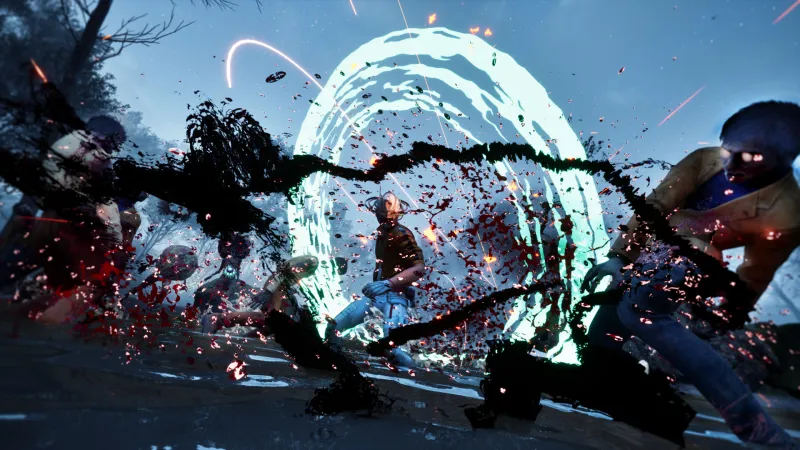
I played Grasshopper Manufacture's next title, Romeo is a Dead Man, for about 25 minutes (it would've been longer, but I had the opportunity to interview director Suda51, so I dipped early for that), and came away extremely ready for more. My demo began with a setup not too dissimilar from the game's reveal trailer, where I learn protagonist Romeo basically dies, is brought back to life through some sci-fi machinery shenanigans, and now works as an FBI agent/space cop/possible mercenary to kill things in the goriest fashion. He does so with a wide array of weapons, and I tested out half a dozen or so of them against zombies in a foggy backwoods area.
There wasn't much going on narratively, as this preview was more about the gameplay, but I thoroughly enjoyed using the different guns and melee weapons at my disposal. I used machine guns, a rocket launcher shaped like a grasshopper (cheeky), a large two-handed sword, small katana-like swords, a pistol, and more. Everything felt great, and watching the heads of enemies be lopped off or blown off was good fun. I can't overstate how gory Romeo is a Dead Man gets – blood squirts everywhere on screen with each hit, but thanks to the game's unique art style, the violence comes across as more comedic than horrific.
Though I enjoyed my time playing Romeo is a Dead Man, I liked my interview with Suda51 even more. Be on the lookout for that alongside a slightly more in-depth preview of my time playing the game here on Game Informer very soon.
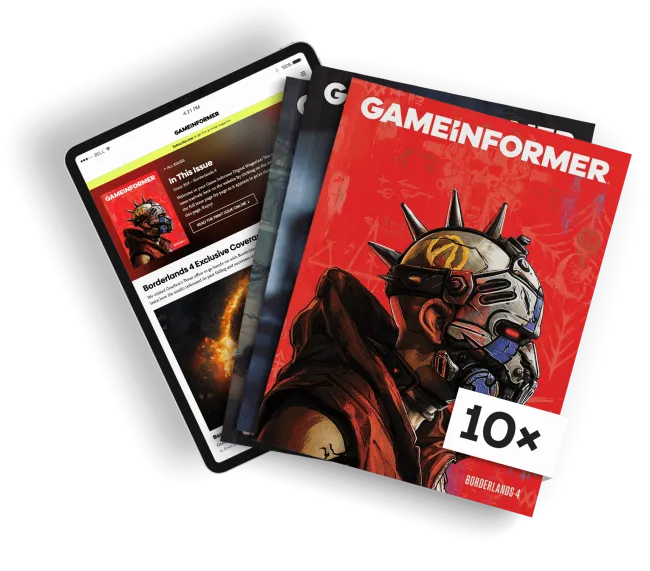
Explore your favorite games in premium print format, delivered to your door.